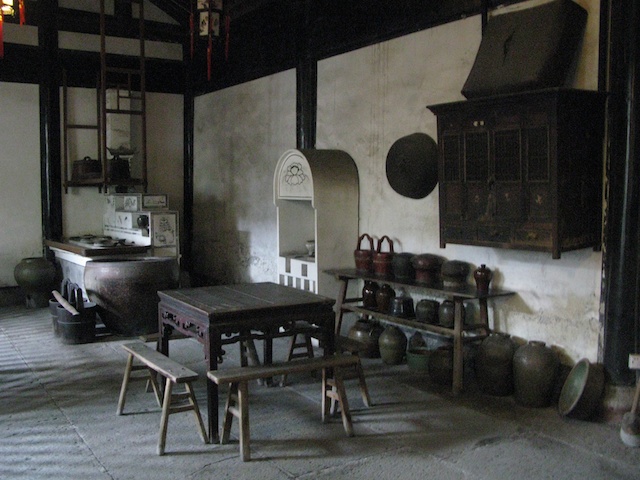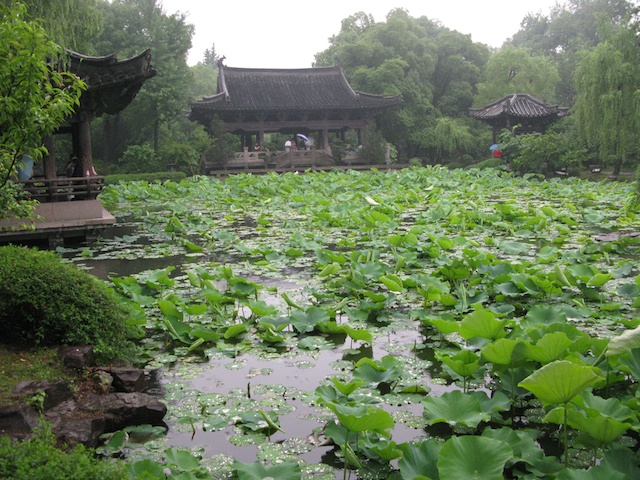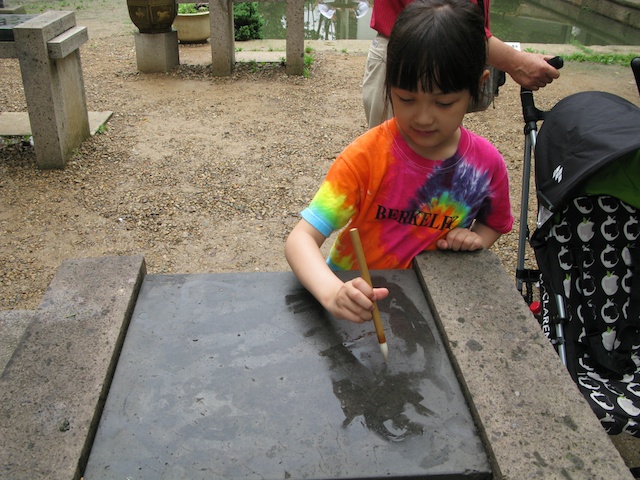
At the entrance to the East Lake in Shaoxing
Other than the obvious choices of Suzhou and Hangzhou, one of my favorite towns to visit within driving distance of Shanghai is Shaoxing. Famous for its rice wine and stinky tofu, this old watertown is located about three hours south-southwest of Shanghai by car or by train. Despite its rampant modernization, with cranes, shopping malls and tall buildings rising up everywhere, the city of four million residents retains a small-town feel. Low hills topped with pagodas grace the city and canals and waterways criss-cross the otherwise urban environment, giving it a quaint beauty that many other watertowns in the Zhejiang-Jiangsu region have either lost or are trying too hard to preserve. In Shaoxing the waterways and their old houses seem to integrate well with the city's more modern features. Tourism in Shaoxing is much bigger than it was six years ago when I first visited the town, but not surprisingly it is geared primarily for domestic rather than international tourists. The city and its environs feature monuments and homages to Wang Xizhi, Lu Xun, and Lu You, all legendary figures of Chinese literature and arts.
Packing my wife, her parents, our two daughters, and a weekend of stuff into our Chevy Blazer, we departed for Shaoxing on Friday evening at around 5 pm. Despite a malfunctioning GPS unit and a couple of missed exits, the trip from Shanghai to Shaoxing was otherwise a smooth one. The superhighways that connect Shanghai, Hangzhou, Ningbo and other big cities in the region provide easy passage into the Zhejiang heartland. One can see the elevated rail line that carries the bullet train from Shanghai to Hangzhou along the way, and now and then a sharp white train whizzes by, heading in one direction or the other. Rest stops along the highways at regular intervals allowed us to get out, stretch, buy some road snacks and use the facilities. While on the road we began to notice a lot of smoke and fire in the countryside that passed us by. The farmers were burning the remains of their first crop of the year and thereby fertilizing their fields for the next crop to come.

Sarah and Hannah posing at the entrance to East Lake
On Saturday morning we braved the rain and ventured out to the East Lake (donghu), located not far from our hotel on the edge of town. The East Lake is a narrow manmade lake fronting high cliffs that have been quarried and carved out of a small mountainside over the centuries. Like the entrance fees to all the other tourist sites we visited over the weekend, it cost 40 RMB for adults and 20 RMB for kids to enter into the lake area. To reach the lake you must cross over a high stone bridge built in 2000 that passes over a functioning canal where barges loaded with coal pass down on frequent intervals.

At the entrance to the lake area a small pondlet leading to the lake is filled with narrow boats, manned by old local men who for a 90 RMB fee will take two or three guests on a guided tour of the lake. We climbed into two boats and the wizened old men guided us around the lake and into tall cavelike areas at the cliff edges.

One of the cave walls features a poem by the famous 20th century poet Guo Moruo. I asked my good friend Martin Winter, poet and translator extraordinaire, to come up with a translation of the poem. Here it is:
箬箦东湖,凿自人工。
壁立千尺,路隘难通。
大舟人洞,坐井观空。
勿谓湖小,天在其中。
East Lake, dug at Ruoze Range:
Walls rise up one thousand feet, paths are hard to navigate.
In the cave, a boat is big; from this well you watch the sky.
Don't you say the lake is small, all that's up there is in here.

The cliff walls are multicolored and covered with lichen and are quite beautiful to see up close.

Our guide told us stories about the different films and TV shows that have been made here including a scene from the Journey to the West featuring an underwater dragon. My wife and her in-laws enjoyed rapping with the guide in a combination of Shanghainese and Shaoxing dialects which are mutually intelligible though distinct. My six-year old daughter was a bit scared in the caves but generally enjoyed the ride.

After our visit to the East Lake, we headed into the center of town to the number one tourist site, the so-called Lu Xun Old Lane (Lu Xun gu li). This walking street features the original family home of famous Chinese writer Lu Xun, whose original name was Zhou Shuren. The street has become fare more heavily commercialized since I first visited it six years ago.

Entry into Lu Xun's family residence was free. The residence is a well-preserved Qing dynasty elite family home with many chambers joined by a central courtyard. These have been stocked with furniture and implements that would have gone with the original rooms, including a kitchen and a dining room where China's greatest modern writer was nourished.

Next to that is a museum dedicated to Lu Xun which we didn't visit. (We have one in Shanghai in any case.) Instead we strolled down to the far end of the walking street and stopped at the Xianheng Jiudian, the city's most famous inn, for lunch. This was the inn featured in Lu Xun's short story Kong Yiji, who appears in bronze form in front of the building.

In 2005, I'd stopped there for a bowl or two of the rice wine they offer at the door. Back then the place had a rustic feel to it and one could imagine some connection to the original inn from the early 20th century. Now that feeling is gone completely as the inn has been entirely rebuilt and is connected to a hotel. It is much larger and fancier now and full of Chinese tourists. The restaurant is a well-oiled machine. Customers buy a card at the front desk and use it to order dishes from the kitchen staff. Customers can order a plate of stinky tofu from a separate window at the very end, where a chef plops plates of tofu squares into a boiling vat of oil.

I have to admit that the stinky tofu was my own favorite dish, washed down with a bowl of their own stock of rice wine.

My wife and her parents absolutely loved the food which is reminiscent of Shanghai fare, i.e. sweet and salty. They enjoyed it so much that they insisted on going there again on Sunday for another lunch meal.

After our visit to Lu Xun's old digs, we walked across the road to visit the Shen Garden (shen yuan). This garden has connections stretching back to the Song Dynasty, and it is a beautiful spot to visit even if it doesn't quite have the charm of Suzhou's Ming Dynasty gardens.

The Shen Garden features a memorial hall dedicated to the "patriotic" Song poet and official Lu You who resided in the neighborhood, and his ill-fated love affair with a woman named Tang Wan.

Wherever we went, I was pretty much the only laowai around. This included the Lanting or Orchid Pavilion, which we visited on Sunday morning. By then the rain had tapered off and we were able to walk around without umbrellas. Again, this spot, located in a secluded rural area outside of Shaoxing and just on the edge of another town bearing the same name as the tourist site, was far more developed for tourism than I recall from six years ago. The site is dedicated to the poet and calligrapher Wang Xizhi, who in the year 353 held a famous party there, inviting a few dozen of his poet friends to drink wine and compose poems commemorating their gathering. Servants floated cups of wine on lotus leaves down the stream, and when they reached the guests, they had to drink them and compose a poem on the spot.

Wang Xizhi wrote a preface to the resulting collection of poems which is now considered one of the greatest works of ancient Chinese literature. A pavilion dedicated to his memory can be found here with a stele featuring the calligraphy of the Qing emperor Kang Xi who once paid a visit to this spot. You can see how the stele was broken during the Cultural Revolution, but it has since been repaired.

There is also another pavilion with a larger stele with Kang Xi's writing.


A magnificent hall with an internal pond and bridge is dedicated to Wang Xizhi and his calligraphy, and every year on the third day of the third month of the lunar calendar, a festival is held here to commemorate China's greatest calligrapher.

I'd like to go someday and see that, though I've been saying this for years and still haven't gotten round to doing it.

All in all, the three-plus hour journey to Shaoxing is well worth the travel time, and for those of us who are into Chinese history and culture, there is plenty on which to ruminate. I feel that every time I go I merely scratch the surface of a place extremely rich in local history, where some of China's brightest luminaries gathered in centuries gone by.

Sarah tries her hand at water calligraphy on a smooth stone located near the halls dedicated to the memory of China's great poet and calligrapher, Wang Xizhi.